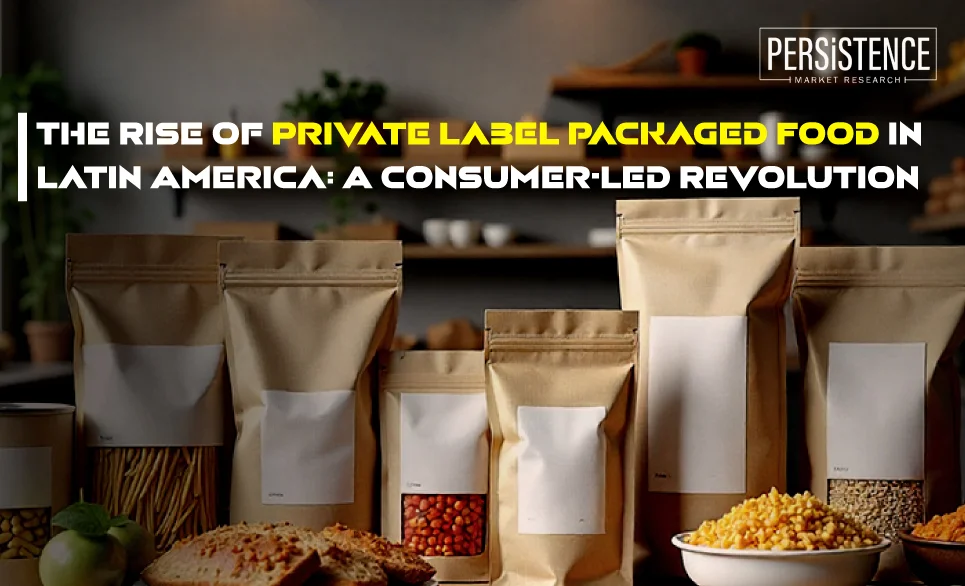- Blog
- Private Label Packaged Food Innovation
The Rise of Private Label Packaged Food in Latin America: A Consumer-Led Revolution
Published On : 29 Jul 2025
In recent years, Latin America has witnessed a remarkable transformation in its packaged food sector, with private label brands gaining significant traction. Traditionally dominated by global food giants, the market is now being reshaped by the growing popularity of retailer-owned brands that offer affordability, improved quality, and trust. This trend reflects deeper changes in consumer behavior, retail strategies, and supply chain innovations.

What are Private Label Packaged Foods?
Private label packaged foods are products manufactured by a third party but sold under a retailer’s brand name. These range from basic food staples like pasta, rice, and canned vegetables to premium offerings such as organic snacks, gluten-free items, and ready meals. Retailers like Walmart, Carrefour, Grupo Éxito, and Cencosud are expanding their private label portfolios across Latin American countries such as Brazil, Mexico, Colombia, Chile, and Argentina.
Key Drivers Behind the Surge
1. Economic Pressures and Value-Driven Consumption
The economic uncertainties that have persisted due to inflation, currency depreciation, and supply chain challenges around the globe have pushed Latin American consumers to be value-driven in their purchases. Since the quality of the private label brands is similar to that of the national brands, but at a lower price, it appeals to middle- and low-income households.
2. Retail Consolidation and Expansion
Major retail chains across Latin America are increasing shelf space for their own brands, leveraging economies of scale, direct procurement, and branding strategies to offer competitive pricing without compromising quality. This gives them more control over margins and consumer engagement.
3. Changing Consumer Perceptions
The perception that private label products are inferior is fading. Shoppers now associate them with value, innovation, and even health-consciousness, due to product diversification and investments in packaging, ingredients, and transparency.
Market Specific Insights
Brazil
Brazil is the fastest-growing region in terms of the development of the private label, particularly in supermarkets and cash-and-carry formats. Retailers are pushing store-brand packaged food across frozen meals, dairy, and snacks, appealing to both budget-conscious and time-pressed consumers.
Mexico
The emergence of convenience formats and OXXO-type retailing has created expansion opportunities for private labels in ready-to-eat and single-serve categories. The Mexican consumers are adopting store brands that focus on nutrition and portability.
Colombia & Chile
Inflation is high in Colombia and Chile, and this has increased the transition to private label bakery, dairy and canned food. Retailers have also introduced tiered private labeling strategies from basic, mid-range, and premium to appeal to various demographics.
Industry Impact
- Manufacturers- OEM (original equipment manufacturers) and contract packagers are seeing a spike in demand from large retail chains.
- Suppliers- Ingredient suppliers need to adapt to volume flexibility, pricing constraints, and innovation cycles to support private label growth.
- Retailers- Enhanced brand equity, customer loyalty, and differentiation are becoming key strategies as retailers expand their private label portfolios.
How are Latin American retailers leveraging private label strategies to enhance profitability and market differentiation?
Retailers are using private-label food products as a core pillar for growth. With in-house brands, they avoid middlemen, enabling better margins while offering competitive pricing. Private labels also allow for exclusive offerings that differentiate them from competitors. For example, some retailers are launching eco-conscious or regionally inspired packaged foods under their brand, capitalizing on local taste preferences and sustainability trends. This multi-tiered strategy improves brand equity and creates a value ecosystem where the customer remains loyal not just to the product, but to the store itself.
What challenges should be overcome for private label packaged food to sustain its growth in Latin America?
Despite the growth, several challenges remain pertinent. Supply chain volatility, especially for imported ingredients, can affect production timelines and cost efficiency. Consumer trust in food safety and transparency must be continuously maintained through rigorous quality assurance. Smaller local retailers may also struggle to compete with the scale and resources of multinational chains, limiting the broader reach of private labels. Moreover, regulatory differences across countries can hinder regional rollouts. To overcome these hurdles, investment in local sourcing, manufacturing agility, and strong supplier partnerships is essential.
Looking Ahead: What’s Next?
As private label packaged foods continue to gain ground, further premiumization, digital expansion (through e-commerce and delivery platforms), and product diversification is expected. Retailers who invest in consumer data, sustainability, and localized flavors will likely lead the next wave of growth. With inflationary pressure persisting and consumer behavior evolving, private label foods are set to become a cornerstone of the Latin American food retail landscape.
Industry Report

Request Report Sample
Your privacy is important to us; your data is secure
Contact Us
Latest Reports
-
Piezoresistive Pressure Sensor Market by Sensor Type (Absolute, Gauge, Differential, Sealed), Pressure Range (Low Pressure (<10 kPa), Medium Pressure (10 kPa – 1000 kPa), High Pressure (>1000 kPa)), End-Use Industry (Automotive & Transportation, Industrial Manufacturing, Healthcare, Aerospace & Defense, Electronics) and Regional Analysis for 2026-2033
-
Aquarium Accessories Market by Product Type (Filtration Items, Lights & Hoods, Temperature Control Systems, Others), End-User (Residential, Commercial), Distribution Channel (Online, Offline), and Regional Analysis for 2026-2033
-
Oxygen Therapy Market by Product Type (Compressed Oxygen, Concentrated Oxygen, Liquid Oxygen), Disease (Respiratory Disorder, Cardiovascular Disease, Sleep Apnea, Pneumonia), End-User (Hospitals, Home Healthcare, Clinics), and Regional Analysis for 2026-2033
-
Air Curtains Market by Product Type (Non‑Recirculating, Recirculating, Heated, Others), Airflow Capacity (Up to 500 m³/h, 500–1000 m³/h, 1000–1500 m³/h, Above 1500 m³/h), Application (Commercial, Industrial, Residential, Others), and Regional Analysis for 2026–2033
-
Personalized Stationery Market by Product type (Storage & Filling Products, Paper-Based Products, Drawing & Writing Instruments, Accessories, Bags, Others), Application (Educational Institutes, Corporate Offices, Personal Use, Hospitals, Others), and Regional Analysis for 2026–2033
